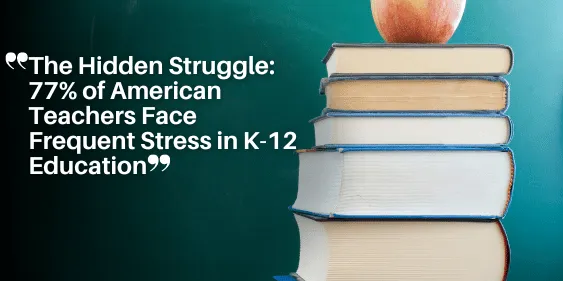The Hidden Struggle: 77% of American Teachers Face Frequent Stress in K-12 Education

The Extent of Stress
Uncovering the hidden struggles faced by teachers in America reveals a staggering statistic: 77% of K-12 educators report experiencing frequent stress.
The weight of this figure cannot be ignored when considering the numerous responsibilities shouldered by these professionals.
A closer look reveals that 68% of teachers feel perpetually overwhelmed by their workload, a sentiment that further underscores the demanding nature of the teaching profession.
Workload Pressure
The overwhelming workload teachers face is not simply a byproduct of managing classrooms.
It involves developing lesson plans, grading assignments, and providing individual support to students.
The administrative tasks alone can consume significant portions of their time, leaving little room for personal well-being or professional growth. Comparing this stress to other professions, teachers often rank higher in stress levels than workers in many other fields.
Comparison to Other Professions
Teachers’ stress levels surpass those of professionals in several other sectors.
For instance, a broader look at different careers highlights how educators consistently report higher rates of fatigue and emotional strain.
Unlike many other professions, teachers often find themselves unable to detach from their work even during off-hours, which exacerbates stress and impacts overall life satisfaction.
Understanding the gravity of these revelations sets the stage for a deeper exploration of the additional factors contributing to this alarming state of teacher stress.
Factors Contributing to Teacher Stress
Political Interference in Education
Political dynamics profoundly impact the educational landscape, often relegating teachers to the sidelines.
Decisions on curricula, standardized testing, and funding are frequently influenced by political agendas, which may not align with educational best practices. This top-down approach leaves teachers feeling undervalued and unempowered.
Political interference amplifies teachers’ stress by adding layers of bureaucracy and shifting priorities, making it challenging to maintain a stable and effective teaching environment.
Impact of the COVID-19 Pandemic
The COVID-19 pandemic irrevocably changed the educational sector.
Teachers had to pivot to online learning almost overnight, and the rapid shift was fraught with technical difficulties, lack of resources, and inadequate training. The lingering effects continue to haunt educators.
Many are still grappling with learning gaps and social-emotional challenges that surfaced during this period.
The urgency to adapt while ensuring quality education further escalates stress levels among teachers, who already feel overwhelmed by their workload.
Understaffing in Schools
A staggering 70% of teachers report perpetual understaffing as a critical issue within their schools.
This scarcity of support staff places an enormous burden on existing faculty, compelling them to take on additional responsibilities.
Educators find themselves juggling multiple roles—teaching, administrative duties, and often serving as counselors for their students.
This multitasking amplifies stress and leaves little room for educators to focus on their primary duty: teaching.
The relentless demand for their time and skills can lead to burnout, affecting their overall well-being and the quality of education delivered.
By recognizing these key stressors, we can better understand the complex nature of teaching and the heavy toll it takes on educators.
Now, let’s delve into the external challenges that exacerbate these internal pressures.
External Challenges Affecting Education
Poverty: A Major Obstacle for Students
Poverty deeply impacts students’ academic performance and overall well-being.
It’s a rock-heavy burden that weighs down entire communities, including students and teachers.
More than half of the teachers reported that poverty is the most significant challenge their students face.
In economically distressed areas, students often come to school hungry, tired, or stressed about issues at home.
These factors severely hinder their ability to focus in class and keep up with their peers.
Chronic Absenteeism: A Persistent Problem
Chronic absenteeism is another significant hurdle, particularly in high school settings.
Absenteeism not only disrupts the learning process for the student missing classes but also for teachers who have to repeatedly catch them up. This constant cycle can be tiring for both parties involved.
Teachers attribute this absenteeism to various factors such as family responsibilities, health issues, and a lack of engagement in school.
High-poverty areas see this problem magnified, intensifying the struggle to provide consistent, quality education.
Mental Health Issues: An Increasing Concern
Mental health issues, notably anxiety and depression, also loom large over the educational landscape, especially in high-poverty areas.
The stress of facing uncertain futures while dealing with academic pressures can take a toll on students, sharply affecting their performance.
About 70% of teachers mention that mental health problems are prevalent in their schools, further complicating classroom management and personalizing instructional methods for affected students.
Addressing these challenges requires a holistic approach involving not only educators but also the community and policymakers.
Tackling poverty, reducing absenteeism, and supporting mental health initiatives are critical steps in creating a more equitable educational environment.
As we delve deeper into examining these challenges, we must also look at how educators themselves are surviving this demanding profession.
Work-Life Balance Struggles
The Overwhelming Reality
Balancing personal life and work is a huge challenge for many teachers. Over half (54%) say they struggle with it, and it’s not hard to see why.
Classroom work doesn’t end when the bell rings; lesson planning, grading, and parent communication often spill into their personal time.
An astounding 84% of teachers report that they lack time to complete tasks during regular hours, leading to missed family events and late-night work sessions.
Gender Disparities in Balancing Acts
Interestingly, the burden isn’t evenly distributed. Female teachers face a tougher struggle, with 57% experiencing challenges compared to 43% of their male counterparts.
This disparity underscores the need for more structural support mechanisms tailored to address this imbalance. Women often juggle multiple roles both at home and at work, making the quest for balance even more elusive.
The ripple effect
Failing to achieve work-life balance affects more than just teachers’ well-being.
It impacts their job satisfaction and the quality of education they provide.
Educators who manage to balance find themselves more satisfied and better performing, proving that effective support systems are crucial. Organizations and communities need to prioritize creating an environment that allows teachers to disconnect from work and focus on personal rejuvenation.
Teachers’ struggles with work-life balance are a significant part of the broader issues they face.
The ripple effect of this problem touches various aspects of their lives, making holistic support systems necessary for their well-being and the betterment of education.
Transitioning to another vital aspect of educators’ experiences, we now turn our attention to how they view the future of education, revealing their deeper concerns and hopes.
Pessimism About the Future of Education
A Bleak Outlook
The future of education looks grim to a vast majority of American teachers. Only 20% of educators believe conditions will improve in the next five years, while a significant 53% foresee worsening circumstances.
This pessimism stems from several factors, deeply rooted in their daily experiences and broader societal issues.
Key Concerns
One major worry is the perceived decline in the quality of education.
82% of teachers feel that the standard of education has deteriorated over recent years. This decline is attributed to numerous factors, including political interference, the lasting impacts of the COVID-19 pandemic, and constraints from limited resources as detailed in the previous chapters.
Political and Pandemic Influences
Political interference remains a persistent issue. Over 30% of teachers express doubt about the ability of major political parties to address crucial educational issues effectively.
For many educators, this creates an uncertain environment where policies can change rapidly, adding to their stress and complicating their work.
The pandemic has only magnified these issues, with abrupt transitions to online learning and subsequent challenges as schools reopened.
Limited Resources and Their Impact
The constraint of limited resources exacerbates the situation. Insufficient funding leads to understaffing, larger class sizes, and inadequate supplies, pushing teachers to the brink. Educators frequently find themselves dipping into personal funds to provide for their students, highlighting a system in urgent need of support.
The Emotional Toll
This gloomy outlook has a tangible effect on teachers’ morale. Facing a litany of challenges from every direction, it becomes increasingly difficult for educators to maintain enthusiasm for their profession.
The high levels of stress and the sense of being overwhelmed are not just statistics; they represent the lived realities of those shaping the next generation.
Understanding these concerns is the first step. By collectively acknowledging and addressing them, we can begin to foster an environment where teachers feel valued and supported.
Coping Strategies and Support Systems
Importance of Peer Support Networks
For the majority of teachers, peer support networks serve as a vital lifeline. Educators often find comfort and strength in connecting with colleagues who face similar challenges.
These networks offer emotional support, advice, and shared resources, helping to alleviate the feelings of isolation that many teachers experience.
Peer networks can be formal, such as teacher associations, or informal, like coffee breaks with colleagues.
These connections are crucial in fostering a sense of community and solidarity within schools, increasing resilience against stress and burnout.
Need for Effective Time Management Strategies
Effective time management is another crucial strategy for mitigating teacher stress.
Given that 84% of teachers report lacking the time to complete tasks during regular hours, developing robust time management skills is essential.
Techniques such as prioritizing tasks, setting realistic goals, and allocating specific times for grading and lesson planning can make a significant difference.
Tools like planners and digital apps are also invaluable for tracking assignments, deadlines, and meetings, enabling teachers to manage their workload more efficiently and reduce the overwhelming pressure they often face.
Role of Professional Development and Self-Care Practices
Ongoing professional development and dedicated self-care practices are equally important in managing stress.
Engaging in professional development not only enhances teaching skills but also provides a sense of achievement and growth, which can be highly motivating. Workshops, seminars, and online courses offer avenues for teachers to learn new strategies and stay updated with education trends.
Self-care practices, such as mindfulness, exercise, and hobbies, play a critical role in maintaining mental and physical health.
Teachers must prioritize activities that bring joy and relaxation outside the classroom to rejuvenate and combat stress effectively.
Balancing work responsibilities with personal well-being is crucial for sustaining long-term productivity and satisfaction in the teaching profession.
While it’s evident that the challenges teachers face are multifaceted, implementing these coping strategies and support systems can make a significant difference in their professional and personal lives.
By fostering strong peer networks, mastering time management, and committing to continuous development and self-care, teachers can navigate their demanding roles more effectively.
Recognizing these needs and acting on them will pave the way for a better educational environment, not just for teachers but for students as well.







